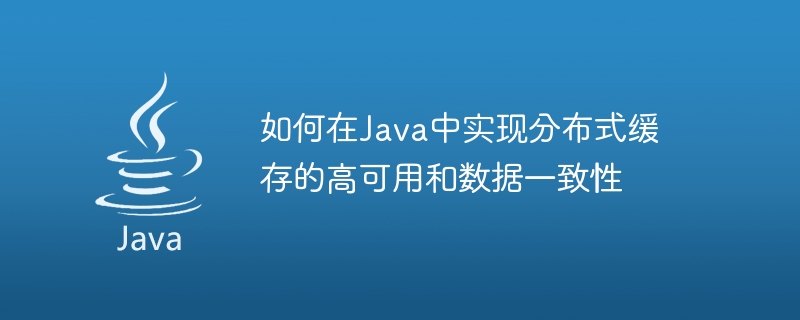如何在Java中實現分散式快取的高可用和資料一致性
- 王林原創
- 2023-10-09 20:10:55855瀏覽

如何在Java中實現分散式快取的高可用和資料一致性
在分散式系統中,快取是提高效能和減少資料庫壓力的常用手段之一。然而,單點故障和資料一致性問題是使用分散式快取時需要解決的兩個主要挑戰。本文將介紹如何在Java中實現分散式快取的高可用和資料一致性,並提供具體的程式碼範例。
一、高可用的實作
- 使用一致性雜湊演算法
在分散式快取系統中,使用一致性雜湊演算法可以讓資料在多個節點上均勻分佈,從而提高系統的可用性。一致性雜湊演算法的基本原理是將節點和資料都映射到一個環上,當需要快取或獲取資料時,根據資料的雜湊值在環上找到對應的節點。
以下是一致性雜湊演算法的Java實作範例:
public class ConsistentHashing {
private final TreeMap<Long, String> nodes = new TreeMap<>();
private final int replicaNum; // 虚拟节点的数量
private final HashFunction hashFunction; // 哈希函数
public ConsistentHashing(HashFunction hashFunction, int replicaNum, Collection<String> nodes) {
this.hashFunction = hashFunction;
this.replicaNum = replicaNum;
// 添加实际的节点
for (String node : nodes) {
addNode(node);
}
}
public void addNode(String node) {
// 添加虚拟节点
for (int i = 0; i < replicaNum; i++) {
long hash = hashFunction.hash(node + i);
nodes.put(hash, node);
}
}
public void removeNode(String node) {
// 移除虚拟节点
for (int i = 0; i < replicaNum; i++) {
long hash = hashFunction.hash(node + i);
nodes.remove(hash);
}
}
public String getNode(String key) {
if (nodes.isEmpty()) {
return null;
}
// 计算数据的哈希值
long hash = hashFunction.hash(key);
// 在环上找到第一个大于等于该哈希值的节点
Map.Entry<Long, String> entry = nodes.ceilingEntry(hash);
// 如果不存在,则返回环上第一个节点
if (entry == null) {
entry = nodes.firstEntry();
}
return entry.getValue();
}
}
public interface HashFunction {
long hash(String key);
}- 使用心跳機制
為了實現快取系統的高可用性,可以使用心跳機制監測快取節點的狀態。每個節點以一定的時間間隔發送心跳訊號給其他節點,如果某個節點一段時間內沒有接收到心跳訊號,就認為該節點宕機,可以將其從快取節點清單中移除。
以下是使用心跳機制實現高可用的Java程式碼範例:
public class Heartbeat {
private final List<String> nodes; // 缓存节点列表
private final long interval; // 心跳间隔
public Heartbeat(List<String> nodes, long interval) {
this.nodes = nodes;
this.interval = interval;
}
public void startHeartbeat() {
ScheduledExecutorService executor = Executors.newSingleThreadScheduledExecutor();
executor.scheduleAtFixedRate(() -> {
for (String node : nodes) {
// 发送心跳信号
boolean result = sendHeartbeat(node);
if (!result) {
// 节点宕机,从节点列表中移除
removeNode(node);
}
}
}, 0, interval, TimeUnit.MILLISECONDS);
}
private boolean sendHeartbeat(String node) {
// 发送心跳信号的具体逻辑
// 返回是否成功接收到心跳信号
return true;
}
private void removeNode(String node) {
// 从节点列表中移除宕机的节点
}
}以上程式碼範例示範如何使用一致性雜湊演算法和心跳機制實作分散式快取的高可用性。
二、資料一致性的實作
- 使用快取更新策略
在分散式快取系統中,快取更新策略是實現資料一致性的重要方法。在寫入資料時,可以透過同時更新快取和資料庫來確保資料的一致性。
以下是使用快取更新策略實現資料一致性的Java範例程式碼:
public class Cache {
public void put(String key, Object value) {
// 写入缓存
// 更新数据库
}
public Object get(String key) {
Object value = null;
// 从缓存读取数据
if (value == null) {
// 从数据库读取数据
// 写入缓存
}
return value;
}
public void delete(String key) {
// 从缓存删除数据
// 更新数据库
}
}- 使用版本控制機制
另一種實作資料一致性的方法是使用版本控制機制。每次更新資料時,都會將版本號加一,並將版本號和資料一起儲存到快取中。讀取資料時,比較快取中的版本號和資料庫中的版本號,如果不一致,則重新從資料庫讀取資料。
以下是使用版本控制機制實現資料一致性的Java範例程式碼:
public class Cache {
private final Map<String, VersionedValue> data = new HashMap<>();
public void put(String key, Object value) {
VersionedValue versionedValue = data.get(key);
if (versionedValue == null) {
versionedValue = new VersionedValue(1, value);
} else {
versionedValue.setValue(value);
versionedValue.incrementVersion();
}
data.put(key, versionedValue);
// 更新数据库
}
public Object get(String key) {
VersionedValue versionedValue = data.get(key);
if (versionedValue == null) {
// 从数据库读取数据
// 更新缓存
} else {
// 比较版本号
// 从缓存读取数据
}
return versionedValue.getValue();
}
public void delete(String key) {
data.remove(key);
// 更新数据库
}
}
public class VersionedValue {
private int version;
private Object value;
public VersionedValue(int version, Object value) {
this.version = version;
this.value = value;
}
public int getVersion() {
return version;
}
public void incrementVersion() {
this.version++;
}
public Object getValue() {
return value;
}
public void setValue(Object value) {
this.value = value;
}
}以上程式碼範例示範如何使用快取更新策略和版本控制機制實作分散式快取的數據一致性。
綜上所述,實現分散式快取的高可用性和資料一致性是比較複雜的,需要綜合使用一致性雜湊演算法、心跳機制、快取更新策略和版本控制機制等技術。透過合理的設計和實現,可以提高分散式快取系統的效能和可靠性。
以上是如何在Java中實現分散式快取的高可用和資料一致性的詳細內容。更多資訊請關注PHP中文網其他相關文章!
陳述:
本文內容由網友自願投稿,版權歸原作者所有。本站不承擔相應的法律責任。如發現涉嫌抄襲或侵權的內容,請聯絡admin@php.cn

